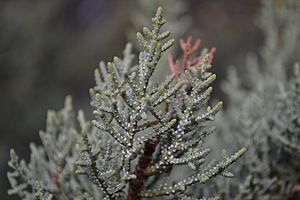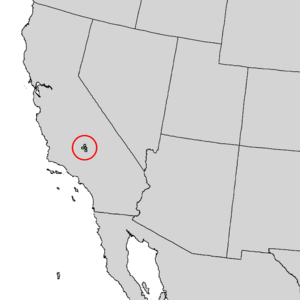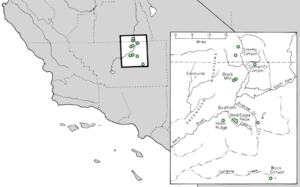Cupressus nevadensis facts for kids
Quick facts for kids Cupressus nevadensis |
|
|---|---|
 |
|
| Foliage is highly glandular, resinous, and aromatic. | |
| Conservation status | |
| Scientific classification | |
| Genus: |
Cupressus
|
| Species: |
nevadensis
|
 |
|
| Natural range of Cupressus nevadensis | |
 |
|
| Close-up of natural range of Cupressus nevadensis | |
| Synonyms | |
|
Hesperocyparis nevadensis − (Abrams) Bartel, (current botanical name) |
|
The Paiute cypress (scientific name: Hesperocyparis nevadensis) is a special type of cypress tree. It grows naturally in a small part of the Sierra Nevada mountains in California, in the western United States. It used to be called Cupressus nevadensis, but scientists have given it a new name.
Contents
Where Paiute Cypress Grow
This tree lives in a small part of the Southern Sierra Nevada mountains. You can find it in Kern County, California and Tulare County. It likes to grow in rocky soil that comes from granite. These trees are found at high places, from about 900 to 1,800 meters (3,000 to 6,000 feet) above sea level.
Paiute cypress trees live in different kinds of natural areas. These include woodlands with pinyon pines and junipers, and oak and pine forests. They also grow in chaparral, which is a type of shrubland. The biggest group of these trees is near Bodfish, close to Lake Isabella. There are also about eight other smaller groups scattered around the Southern Sierras.
What Paiute Cypress Look Like
The Paiute cypress is a medium-sized evergreen tree. This means it stays green all year round. It has a cone shape at the top. These trees usually grow to be 10 to 25 meters (about 33 to 82 feet) tall. Some can even reach 39 meters (about 128 feet)! Their trunks can be up to 0.5 meters (about 1.6 feet) wide, and sometimes even 1 meter (about 3.3 feet) wide.
The leaves grow in thin, spread-out bunches. They smell very nice. Their color can be a dull gray-green or a cool blue-green. The leaves are like small scales, about 2 to 5 millimeters long. They are sticky and full of a special liquid called resin, which makes them smell so good.
The tree's cones are round or a bit oval-shaped. They are 25 to 55 millimeters long. Each cone has 6 or 8 scales, but sometimes 4 or 10. When they are young, they are green to brown. After about 20 to 24 months, they turn gray or gray-brown. The male cones are smaller, about 3 to 5 millimeters long. They release pollen in February or March.
How Fire Helps Them Grow
A cool thing about these cones is that they often stay closed for many years. They only open up after the parent tree is burned in a wildfire. This allows the seeds inside to fall onto the ground that has been cleared by the fire. This helps new trees start to grow.
Protecting the Paiute Cypress
Like many cypress trees in California, the Paiute cypress needs wildfires to help it grow new trees. It is a pyrophyte, which means it relies a lot on fire to reproduce. For many years, people have tried to stop wildfires. This has made it hard for this tree to make new trees.
Because of this, the Paiute cypress is now on the IUCN Red List. This list shows plants and animals that are in danger of disappearing. The Paiute cypress is listed as an endangered species. This means it needs our help to survive.
About Its Name
Scientists have recently changed the official group, or genus, that the Paiute cypress belongs to. It is now in the genus Hesperocyparis. Many other cypress trees from western North America have also been moved to this group. Before this, it was sometimes thought to be a type of Arizona cypress. It was called Cupressus arizonica subsp. nevadensis.


